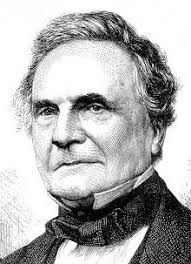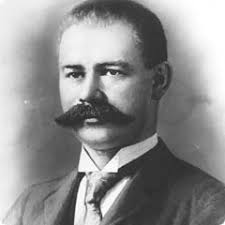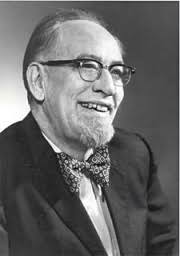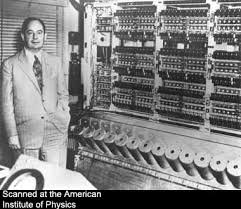In The Beginning...
The history of computers starts out about 2000
years ago, at the birth of the abacus, a wooden rack holding two horizontal wires with
beads strung on them. When these beads are moved around, according to programming rules memorized by the user, all regular arithmetic problems can
be done. Another important invention around the same time was the Astrolabe, used for navigation.Blaise Pascal is
usually credited for building the first digital computer in 1642. It
added numbers entered with dials and was made to help his father, a tax
collector. In 1671, Gottfried Wilhelm von Leibniz invented a computer that was
built in 1694. It could add, and, after changing some things around, multiply. Leibniz invented a special stepped gear mechanism for introducing
the addend digits, and this is still being used.
The prototypes made by Pascal and Leibniz were not used in many places, and considered
weird until a little more than a century later, when Thomas of Colmar (A.K.A.
Charles Xavier Thomas) created the first successful mechanical calculator that could add, subtract, multiply, and divide. A
lot of improved desktop calculators by many inventors followed, so that by
about 1890, the range of improvements included:
l Accumulation of partial
results
l Storage and automatic
reentry of past results (A memory function)
l Printing of the results
Each of these required manual installation. These
improvements were mainly made for commercial users, and not for the needs of
science.
 Babbage Babbage
While Thomas of Colmar was developing the desktop calculator, a series of very interesting developments in
computers was started in Cambridge, England, by Charles Babbage (left, of which the computer store "Babbages" is named), a mathematics professor. In 1812, Babbage realized that many long calculations, especially those needed to
make mathematical tables, were really a series of predictable actions that were
constantly repeated. From this he suspected that it should be possible to do
these automatically.
He began to design an automatic mechanical
calculating machine, which he called a difference engine. By 1822, he had a working model to demonstrate with. With
financial help from the British government, Babbage started fabrication of a
difference engine in 1823. It was intended to be steam powered and fully
automatic, including the printing of the resulting tables, and commanded by a
fixed instruction program. The difference engine, although having limited
adaptability and applicability, was really a great advance. Babbage continued to work on it for the next 10 years, but in 1833 he
lost interest because he thought he had a better idea -- the
construction of what would now be called a general purpose, fully
program-controlled, automatic mechanical digital computer. Babbage called this idea an Analytical Engine. The ideas of this
design showed a lot of foresight, although this couldn’t be appreciated until a
full century later. The plans for this engine required an identical decimal
computer operating on numbers of 50 decimaldigits (or words) and having a
storage capacity (memory) of 1,000 such digits. The built-in operations were
supposed to include everything that a modern general - purpose computer would
need, even the all important Conditional Control Transfer Capability that
would allow commands to be executed in any order, not just the order in which
they were programmed. The analytical engine was soon to use punched cards (similar to those used in a Jacquard loom), which would be read
into the machine from several different Reading Stations. The machine
was supposed to operate automatically, by steam power, and require only one
person there.
Babbage's computers were never finished. Various reasons are used for
his failure. Most used is the lack of precision machining techniques at the
time. Another speculation is that Babbage was working on a solution of
a problem that few people in 1840 really needed to solve. After Babbage, there was a temporary loss of interest in automatic digital
computers.
Between 1850 and 1900 great advances were made in
mathematical physics, and it came to be known that most observable dynamic
phenomena can be identified by differential equations (which meantthat most events occurring in nature can be measured
or described in one equation or another), so that easy means for their
calculation would be helpful.
Moreover, from a practical view, the availability
of steam power caused manufacturing (boilers), transportation (steam engines
and boats), and commerce to prosper and led to a period of a lot of engineering
achievements. The designing of railroads, and the making of steamships, textile
mills, and bridges required differential
calculus to determine such things as:
l center of gravity
l center of buoyancy
l moment of inertia
l stress distributions
Even the assessment of the power output of a
steam engine needed mathematical integration. A strong need thus developed for
a machine that could rapidly perform many repetitive calculations.
 Use of Punched Cards by Hollerith Use of Punched Cards by Hollerith
A step towards automated computing was the
development of punched cards, which were first successfully used with computers
in 1890 by Herman Hollerith (left) and James Powers, who worked for
the US. Census Bureau. They developed devices that could read the
information that had been punched into the cards automatically, without human
help. Because of this, reading errors were reduced dramatically, work flow increased,
and, most importantly, stacks of punched cards could be used as easily
accessible memory of almost unlimited size. Furthermore, different problems
could be stored on different stacks of cards and accessed when needed.
These advantages were seen by commercial
companies and soon led to the development of improved punch-card using
computers created by International Business
Machines (IBM), Remington (yes, the same people that make shavers), Burroughs, and other
corporations. These computers used electromechanical devices in which electrical
power provided mechanical motion -- like turning the wheels of an adding
machine. Such systems included features to:
l feed in a specified number
of cards automatically
l add, multiply, and sort
l feed out cards with punched
results
As compared to today’s machines, these computers
were slow, usually processing 50 - 220 cards per minute, each card holding
about 80 decimal numbers (characters). At the time, however, punched cards were
a huge step forward. They provided a means of I/O, and memory storage on a huge
scale. For more than 50 years after their first use, punched card machines did
most of the world’s first business computing, and a considerable amount of the
computing work in science.
 Electronic Digital Computers Electronic Digital Computers
The start of World War II produced a large need
for computer capacity, especially for the military. New weapons were made for
which trajectory tables and other essential data were needed. In 1942,
John P. Eckert, John W. Mauchly (left), and their associates at the Moore school of Electrical Engineering of
University of Pennsylvania decided
to build a high - speed
electronic computer to do the job. This machine
became known as ENIAC (Electrical Numerical Integrator And Calculator) The
size of ENIAC’s numerical "word" was 10 decimal
digits, and it could multiply two of these numbers at a rate of 300 per second,
by finding the
value of each product from a multiplication table
stored in its memory.
ENIAC was therefore about 1,000 times faster then the previous
generation
of relay computers. ENIAC used 18,000 vacuum tubes, about 1,800 square feet of floor
space,
and consumed about 180,000 watts of electrical
power. It had punched card I/O, 1 multiplier, 1 divider/square rooter, and 20
adders using decimal ring counters , which served as adders and also as quick-access
(.0002 seconds) read-write register storage. The executable instructions making
up a program were embodied in the separate "units" of ENIAC, which were plugged together to form a "route" for
the flow of information.
 These connections had to be redone after each
computation, together with presetting function tables and switches. This "wire
your own" technique was inconvenient (for obvious reasons), and with only
some latitude could ENIAC be considered programmable. It was, however,
efficient in handling the particular programs for which it had been designed. ENIAC is commonly accepted as the first successful high – speed electronic
digital computer (EDC) and was used from 1946 to 1955. A controversy developed
in 1971, however, over the patentability of ENIAC's basic digital concepts,
the claim being made that another physicist, John V. Atanasoff (left ) had already used basically the same ideas in a
simpler vacuum - tube device he had built in the 1930’s while at Iowa State College. In 1973 the courts found in favor of the company using the
Atanasoff claim. These connections had to be redone after each
computation, together with presetting function tables and switches. This "wire
your own" technique was inconvenient (for obvious reasons), and with only
some latitude could ENIAC be considered programmable. It was, however,
efficient in handling the particular programs for which it had been designed. ENIAC is commonly accepted as the first successful high – speed electronic
digital computer (EDC) and was used from 1946 to 1955. A controversy developed
in 1971, however, over the patentability of ENIAC's basic digital concepts,
the claim being made that another physicist, John V. Atanasoff (left ) had already used basically the same ideas in a
simpler vacuum - tube device he had built in the 1930’s while at Iowa State College. In 1973 the courts found in favor of the company using the
Atanasoff claim.
 The Modern Stored Program EDC Fascinated by the
success of ENIAC, the mathematician John Von Neumann (left) undertook, in 1945, an abstract study of computation
that showed that a computer should have a very simple, fixed physical
structure , and yet be able to execute any kind of computation by means of
a proper programmed control without the need for any change in the unit
itself. The Modern Stored Program EDC Fascinated by the
success of ENIAC, the mathematician John Von Neumann (left) undertook, in 1945, an abstract study of computation
that showed that a computer should have a very simple, fixed physical
structure , and yet be able to execute any kind of computation by means of
a proper programmed control without the need for any change in the unit
itself.
Von Neumann contributed a new awareness of how practical, yet fast computers
should be organized and built. These ideas, usually referred to as the stored -
program technique, became essential for future generations of high - speed
digital computers and were universally adopted.
The Stored - Program technique involves many
features of computer design and function besides the one that it is named
after. In combination, these features make very - high - speed operation attainable.
A glimpse may be provided by considering what 1,000 operations per second
means. If each instruction in a job program were used once in consecutive
order, no human programmer could generate enough instruction to keep the
computer busy.
Arrangements must be made, therefore, for parts
of the job program (called subroutines) to be used repeatedly in a manner that
depends on the way the computation goes. Also, it would clearly be helpful if
instructions could be changed if needed during a computation to make them
behave differently. Von Neumann met these two needs by making a special type of
machine instruction, called a Conditional control transfer - which
allowed the program sequence to be stopped and started again at any point - and
by storing all instruction programs together with data in the same memory unit,
so that, when needed, instructions could be arithmetically changed in the same
way as data. As a result of these techniques, computing and programming became
much faster, more flexible, and more efficient with work. Regularly used
subroutines did not have to be reprogrammed for each new program, but could be
kept in "libraries" and read into memory only when needed. Thus, much
of a given program could be assembled from the subroutine library. The all -
purpose computer memory became the assembly place in which all parts of a long computation
were kept, worked on piece by piece, and put together to form the final
results. The computer control survived only as an "errand runner" for
the overall process. As soon as the advantage of these techniques became clear,
they became a standard practice.
|